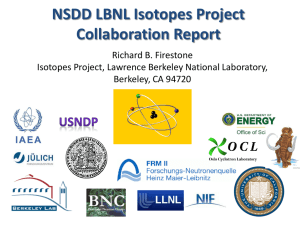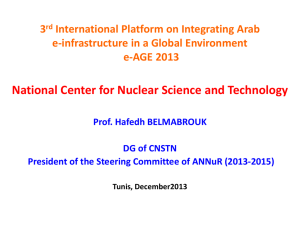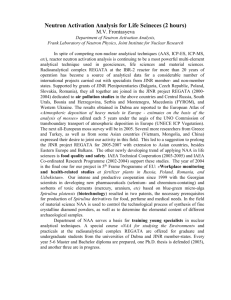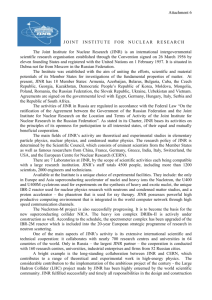JOINT INSTITUTE FOR NUCLEAR RESEARCH
advertisement
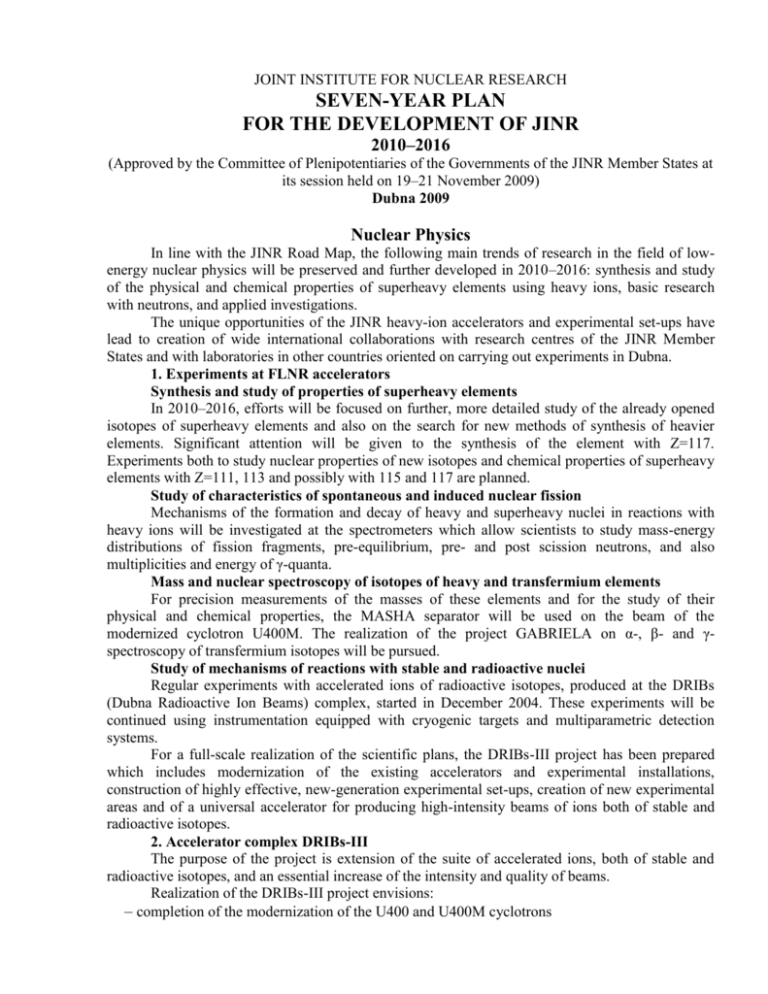
JOINT INSTITUTE FOR NUCLEAR RESEARCH SEVEN-YEAR PLAN FOR THE DEVELOPMENT OF JINR 2010–2016 (Approved by the Committee of Plenipotentiaries of the Governments of the JINR Member States at its session held on 19–21 November 2009) Dubna 2009 Nuclear Physics In line with the JINR Road Map, the following main trends of research in the field of lowenergy nuclear physics will be preserved and further developed in 2010–2016: synthesis and study of the physical and chemical properties of superheavy elements using heavy ions, basic research with neutrons, and applied investigations. The unique opportunities of the JINR heavy-ion accelerators and experimental set-ups have lead to creation of wide international collaborations with research centres of the JINR Member States and with laboratories in other countries oriented on carrying out experiments in Dubna. 1. Experiments at FLNR accelerators Synthesis and study of properties of superheavy elements In 2010–2016, efforts will be focused on further, more detailed study of the already opened isotopes of superheavy elements and also on the search for new methods of synthesis of heavier elements. Significant attention will be given to the synthesis of the element with Z=117. Experiments both to study nuclear properties of new isotopes and chemical properties of superheavy elements with Z=111, 113 and possibly with 115 and 117 are planned. Study of characteristics of spontaneous and induced nuclear fission Mechanisms of the formation and decay of heavy and superheavy nuclei in reactions with heavy ions will be investigated at the spectrometers which allow scientists to study mass-energy distributions of fission fragments, pre-equilibrium, pre- and post scission neutrons, and also multiplicities and energy of γ-quanta. Mass and nuclear spectroscopy of isotopes of heavy and transfermium elements For precision measurements of the masses of these elements and for the study of their physical and chemical properties, the MASHA separator will be used on the beam of the modernized cyclotron U400M. The realization of the project GABRIELA on α-, β- and γspectroscopy of transfermium isotopes will be pursued. Study of mechanisms of reactions with stable and radioactive nuclei Regular experiments with accelerated ions of radioactive isotopes, produced at the DRIBs (Dubna Radioactive Ion Beams) complex, started in December 2004. These experiments will be continued using instrumentation equipped with cryogenic targets and multiparametric detection systems. For a full-scale realization of the scientific plans, the DRIBs-III project has been prepared which includes modernization of the existing accelerators and experimental installations, construction of highly effective, new-generation experimental set-ups, creation of new experimental areas and of a universal accelerator for producing high-intensity beams of ions both of stable and radioactive isotopes. 2. Accelerator complex DRIBs-III The purpose of the project is extension of the suite of accelerated ions, both of stable and radioactive isotopes, and an essential increase of the intensity and quality of beams. Realization of the DRIBs-III project envisions: – completion of the modernization of the U400 and U400М cyclotrons – construction of a new experimental hall – creation of new-generation experimental set-ups – construction of a high-intensity universal accelerator of heavy ions. 3. Construction of a new FLNR experimental hall 2 Construction of a new experimental hall with an area of 2500 м is planned. It will be used for work with beams of radioactive and exotic nuclei and for placing new experimental set-ups, including those from other research centres. Funding (k$) Activities 2010 2011 2012 Modernization of the existing heavy-ion accelerators: 2013 2014 2015 2016 building of complete set of equipment and manufacturing of U400R systems 2 000 installation, adjustment of systems, launching of U400R 1 000 Support of running experiments 1 1 000 000 Construction of a new FLNR experimental hall: 1 000 1 000 1 000 1 000 1 000 technical requirements, project 1 000 civil work 5 000 5 000 gallery, beam lines 2 000 Development and creation of next-generation long-acting experimental set-ups: physical and chemical separators, 1 3 2 2 3 2 2 systems for collecting and 000 000 000 000 000 000 000 transport of nuclear reaction products, radiochemical laboratory of II class, etc. Construction of a high-intensity heavy-ion accelerator (A≤100, E≤10 MeV·A, I≥10 pμA): technical requirements, project manufacturing installation, beam lines, launching Total 3 000 5 000 11 000 11 000 1 000 6 000 2 000 11 000 10 000 16 000 3 000 3 000 4. Next-generation experimental set-ups The Flerov Laboratory has begun work to design the following experimental set-ups: – Universal gas-filled separator for the synthesis of SHE and study of their properties – Cryogenic detector for studying chemical properties of SHE – Pre-separator for radiochemical and mass spectrometry research – Systems for collecting and producing single-charged ions in gas media (gas catcher) for mass spectrometry and for producing RIBs – Radiochemical laboratory, II class – Separator of radioactive neutron-rich nuclei for RIB production 11 – Universal spectrometer for studying reactions induced by RIBs – Wide-aperture spectrometer of spontaneous and induced fission fragments – Electromagnetic separator for studying reactions with RIBs – Prompt-neutron detection system for the DRIBs complex – Gamma-quanta detectors. These projects have a high degree of maturity, and their realization can start within 1–3 months after taking decisions to finance them. 5. Construction of a high-intensity accelerator of heavy ions The new accelerator will significantly increase the potential of the existing accelerator complex of FLNR and will deliver high-intensity beams of accelerated heavy ions of mean masses to the physics instruments in the Laboratory’s new experimental hall. Based on the performed analysis, the cyclic type of the new accelerator –– the DC200 cyclotron –– has been selected. The technical specifications and requirements have been prepared for the new facility, and its designing has started. The new cyclotron will provide acceleration of ions from carbon to xenon up to the energies of 5–10 MeV/n with stepwise and smooth variation. For ions with masses A<100, the beam 13 intensity should be at least 5·10 1/s. Thus, the modernization of the existing accelerators (U400, U400M) and construction of the new cyclic accelerator will create a possibility for conducting experiments with accelerated ions from deuterium to uranium in a broad energy range. Realization of the research programme of the Flerov Laboratory of Nuclear Reactions for the period 2010–2016, based on the accelerator complex DRIBs-III, will allow the Laboratory to widen the spectrum of the research topics to be addressed and to synthesize new superheavy elements. It will also enable JINR to keep its leading position in nuclear research with heavy ions of low and intermediate energies in the nearest 25–30 years. 6. Nuclear physics with neutrons JINR’s traditional research activities in the field of nuclear physics with neutrons will be carried out at a new level due to the high resolution of the new neutron source IREN, which at the same time will be developed. The main task of the IREN first stage development is to reach the designed parameters of the LUE-200 electron accelerator and to provide reliable and stable operation for experimental studies. Schedule of IREN development 2009: start of two-shift operation with electron beam power 1.4 kW (50 Hz frequency, pulse 12 –1 width 200 ns, average energy of electrons 50 MeV, peak current 2.8 A, neutron yield 10 s ). 2010: upgrade of the RF power system with new klystron. This will result in RF power 12 –1 increase and duplicate electron energy with neutron yield 3⋅10 ⋅s . 2011–2012: further upgrade of the RF power system and starting operation with the second accelerating section. This will provide the designed 200 MeV electron energy and beam power 12 –1 about 5.5 kW with neutron yield about 7⋅10 s . 2012–2015: upgrade of the klystron modulators in order to reach the designed value of the repetition rate –– 150 Hz. Design and construction of a uranium non-multiplying target. Reaching of 13 –1 the beam power at the level of 10–15 kW and neutron yield at the level of several units of 10 s , which will position IREN facility in line with the most intense resonance neutron sources of such type. 12 Funding (k$) Activities 2010 2011 2012 2013 Maintenance and operation 70 130 200 250 Upgrade of the RF power system Upgrade of the RF power system, assembling 320 of the second modulator and accelerating section Upgrade of the modulators, design and 360 670 670 construction of the non-multiplying U target Development of the facility 70 180 220 200 systems, experimental and engineering infrastructure Total 340 630 880 1 120 2014 2015 2016 350 350 400 200 100 580 400 250 300 730 1 270 1 230 1 530 Experiments with neutrons Experiments will be also carried out at the IBR-2 reactor, mainly those that require high neutron fluxes, at the EG-5 set-up –– experiments with fast neutrons, low-background measurements and applied studies, and at external neutron sources. The research work will be performed in three main directions: (1) fundamental studies of neutron-induced nuclear reactions, (2) investigations of fundamental properties of the neutron and UCN physics, and (3) applied research. (1) Fundamental studies of neutron-induced nuclear reactions Carrying out of the first experiments at IREN Precise measurement of the weak interaction constant in experiments on P-violation. –8 Determination of the asymmetry coefficient at the level of 10 Search for rare fission modes. Determination of probabilities of exotic decay modes Measurements of total, partial and differential cross sections of (n,p), (n,α) reactions for various isotopes Search for neutron resonances with different structure of wave functions, for various isotopes Search for a singlet deuteron state. Determination of its lifetime or setting the upper limit Obtaining of nuclear data for reactor and construction materials (2) Investigations of fundamental properties of the neutron, and UCN physics Direct measurement of the n-n scattering amplitude with accuracy 5–10% Investigation of the effect of accelerated matter, in particular in experiments with giant 2009 2012 2013– 2014 2010– 2016 2012– 2016 2012 2012– 2016 2012 2013 5 acceleration 10 g –4 Verification of the weak equivalence principle for the neutron with accuracy of 10 at –5 the first stage and 10 in the future Measurement of double differential scattering cross sections of UCN and VCN at nanostructures. Development of a new type of UCN sources Measurement of n,e-scattering length using new methods. Determination of the n,escattering length with accuracy ~ 2–3% (3) Applied research Construction of the detector system for gamma activation analysis at IREN. Performing the experiments Construction of the test bench for applied research at IREN. Experiments on isotope production Performing the biomonitoring of different regions of Russia and JINR Member States using neutron activation analysis; analysis of new materials, surfaces, and food quality; biometric studies 2014– 2016 2015– 2016 2012 2010/ 2011– 2016 2010/ 2011– 2016 2010– 2016 Funding (k$) Activities 2010 2011 2012 2013 2014 2015 2016 Fundamental studies of neutron-induced nuclear 35 80 125 170 185 255 280 reactions Investigations of fundamental properties of the 45 80 90 95 95 100 155 neutron, and UCN physics Applied research 65 110 155 210 255 275 315 Total 145 270 370 475 535 630 750




